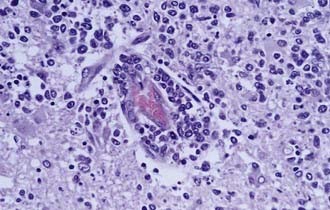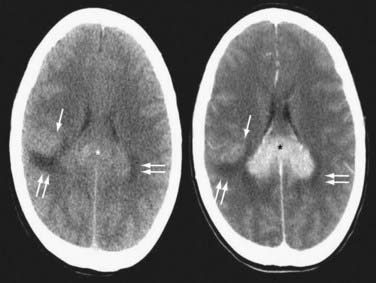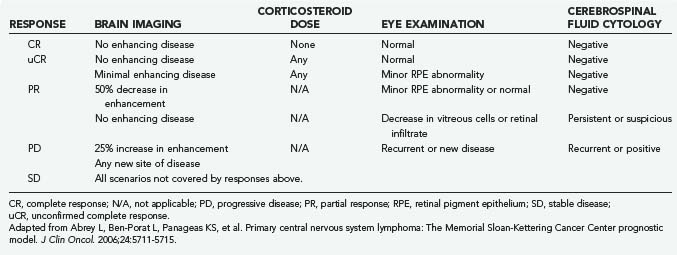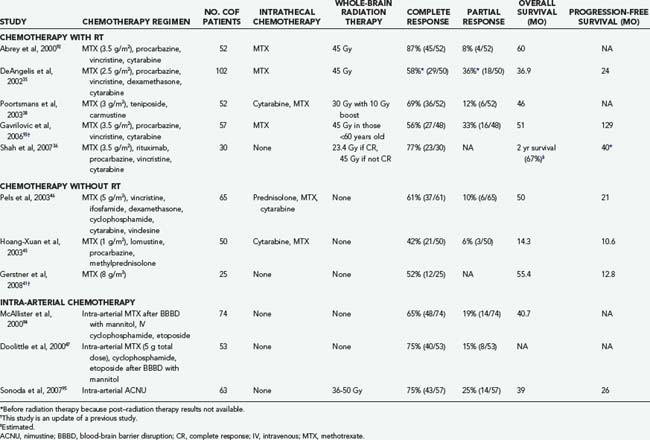CHAPTER 129 Central Nervous System Lymphoma
Primary Central Nervous System Lymphoma
Primary CNS lymphoma (PCNSL) is an uncommon variant of extranodal non-Hodgkin’s lymphoma (NHL) that can affect multiple parts of the CNS, including the eyes, brain, leptomeninges, or spinal cord. PCNSL accounts for about 3% of all the primary CNS tumors diagnosed each year in the United States. The incidence of PCNSL increased significantly from 1970 to 2000 largely owing to the human immunodeficiency virus (HIV) pandemic. However, the incidence has stabilized or decreased during the past decade to about 0.47 cases per 100,000 persons.1,2 Congenital or acquired immunodeficiency is the only established risk factor for PCNSL, and HIV-infected individuals are at greater risk for developing this tumor. About 2% to 13% of patients with a previous diagnosis of acquired immunodeficiency syndrome (AIDS) develop PCNSL. Because PCNSL is a rare malignancy, it has been challenging to study, and an effective standard of care has been difficult to establish. Although durable remissions may be achieved for a few years, the tumor relapses in most cases.
Pathobiology
Ninety percent of non–HIV-associated PCNSL is diffuse large B-cell (DLBCL) type, and the remaining 10% are poorly characterized low-grade lymphomas, Burkitt’s lymphomas, or T-cell lymphomas.3 Less is known about these latter, rare variants of PCNSL. The DLBCL type of PCNSL is composed of immunoblasts or centroblasts that have a predilection for blood vessels, resulting in lymphoid clustering around small cerebral vessels (Fig. 129-1). This angiocentric pattern of tumor growth in the CNS is unique for diffuse large B-cell lymphoma. Reactive T-cell infiltrates may also be present in varying degrees, making it difficult for a neuropathologist to discriminate between PCNSL and a reactive process.
PCNSL likely arises from late germinal center or post–germinal center lymphoid cells and may localize to the CNS because of a poorly understood neurotropism.4 Systematic studies of the molecular pathology of PCNSL have rarely been performed largely because of the lack of adequate tumor specimens for research purposes. Most PCNSL patients are diagnosed by stereotactic needle biopsy so that most of the tissue specimen is consumed by the diagnostic evaluation. Despite this limitation, gene expression studies have demonstrated three gene “signatures” associated with PCNSL: germinal center B-cell; activated B-cell, and type 3 large B-cell lymphoma.5 Although these three gene expression patterns parallel systemic DLBCL, there are unique molecular features of PCNSL. For example, extracellular matrix–related genes are upregulated in PCNSL compared with systemic DLBCL.6 Interaction between tumor cells and extracellular matrix proteins specific to the CNS may offer an explanation for the neurotropism of PCNSL.
Several genes associated with interleukin-4 (IL-4), a B-cell growth factor expressed by both tumor vessels and tumor cells, are highly expressed in PCNSL, including X-box binding protein 1 (XBP-1), a regulator of the unfolded protein response (UPR) signaling pathway. The expression of UPR-related genes is important for cell survival under stressful conditions such as hypoxia so that activation of this pathway may promote tumor cell survival in the CNS. STAT6, a mediator of IL-4 signaling, is expressed by tumor cells and tumor endothelia in PCNSL. High expression levels of STAT6 are associated with short survival in PCNSL patients treated with methotrexate (MTX).5
HIV-related PCNSL is typically a large cell lymphoma with immunoblastic and more aggressive features.7,8 These patients are often severely immunocompromised, with CD4 counts less than 50 cells/mm3 at the time of diagnosis, and have had prior AIDS-defining illnesses. Infection by Epstein-Barr virus (EBV), a ubiquitous pathogen normally suppressed by the intact immune system, likely has a role in the pathogenesis of HIV-related PCNSL through transformation of normal B cells into lymphoma cells.
Clinical Features
The presentations of PCNSL in both immunocompromised and immunocompetent patients are similar, with signs of a focal mass lesion in 70% and 61.3% of patients, respectively.9,10 In 248 immunocompetent patients, 43% had neuropsychiatric signs, 33% had increased intracranial pressure, 14% had seizures, and 4% had ocular symptoms.9 In a series of 111 HIV-related PCNSL cases, 43.2% had headache, 21.6% had seizures, and 18% had ataxia.10 HIV-related PCNSL occurs in younger persons with a median age of 31 years, compared with a median age of 60 years in immunocompetent patients.10 Seizures are less common than with other types of brain tumors probably because PCNSL involves predominantly subcortical white matter rather then epileptogenic gray matter. Typically, patients do not present with B symptoms such as fever, weight loss, or night sweats.
Diagnostic Evaluation
The International PCNSL Collaborative Group (IPCG) has established guidelines for the diagnostic evaluation of a patient with suspected PCNSL (Table 129-1).11 These guidelines establish the extent of disease and confirm that the disease is restricted to the CNS. Physical examination should include palpation of the lymphatic chain as well as testicular examination in males. Contrast-enhanced cranial magnetic resonance imaging (MRI) (contrast cranial computed tomography [CT] if MRI is contraindicated); lumbar puncture if not contraindicated (for cell count, protein, glucose, cytology, immunoglobulin heavy-chain [IgH] gene rearrangement and flow cytometry studies); ophthalmologic examination including slit-lamp evaluation; CT of the chest, abdomen, and pelvis; and bone marrow biopsy should be performed. Blood tests for HIV, complete blood count, basic metabolic panel, and lactate dehydrogenase (LDH) level are also recommended. Testicular ultrasound should be considered in men because testicular lymphoma has a predilection to spread to the CNS.
TABLE 129-1 International Primary Central Nervous System Lymphoma Collaborative Group (IPCG) Guidelines for Baseline Evaluation for Clinical Trials

The search for occult systemic disease has become increasingly important because recent evidence suggests that lymphoma may not be restricted to the nervous system in a subpopulation of patients with CNS lymphoma. Identical polymerase chain reaction (PCR) products of clonally rearranged IgH genes were identified in the bone marrow aspirates, blood samples, and brain tumor biopsy specimens in 2 of 24 patients with “primary” CNS lymphoma in one study. In one of these patients, follow-up IgH PCR 24 months after diagnosis yielded a persistent monoclonal blood product despite a complete radiographic response in the CNS.12 In a retrospective study of 49 PCNSL patients evaluated with body fluorodeoxyglucose (FDG) position emission tomography (PET) studies, extraneural hypermetabolic lesions were identified in 15% of subjects. Subsequent tissue biopsy was performed, and 11% of the lesions were found to be lymphoma, whereas 4% were other types of cancer. PET may play an increasingly important role in evaluating patients with PCNSL for subclinical systemic disease.13 Prospective, long-term follow-up studies are necessary to further elucidate the frequency and importance of subclinical systemic disease in CNS lymphoma patients and whether the presence of these monoclonal cell populations increase the risk for relapse.
Neuroimaging
Contrast-enhanced cranial MRI is the imaging modality of choice in evaluating a patient with a suspected diagnosis of PCNSL. If MRI is not possible or is contraindicated, a contrast-enhanced cranial CT scan is recommended. PCNSL tends to enhance homogeneously on both MRI and CT, although in HIV-associated disease, lesions are often ring enhancing (Figs. 129-2 and 129-3; Figs. 129E-1 to 129E-3).7 In immunocompetent PCNSL patients, lesions are solitary in 65% of cases and are located in a cerebral hemisphere (38%), thalamus or basal ganglia (16%), corpus callosum (14%), periventricular region (12%), and cerebellum (9%).14 HIV-related PCNSL is solitary in 48.6% of cases and is localized to the cerebral cortex in 65%, the periventricular region in 56%, the basal ganglia in 33%, the cerebellum in 7%, and the brainstem in 4%.10 Isolated spinal cord involvement is rare and is observed in less than 1% of cases, so spinal imaging is necessary only if warranted based on clinical suspicion or to screen for leptomeningeal involvement if lumbar puncture cannot be performed.
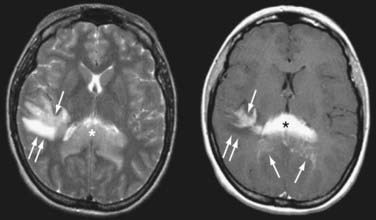
FIGURE 129-3 Axial magnetic resonance imaging (MRI) of the same patient in Figure 129-2. Axial T2-weighted MRI (left) shows that the splenial (asterisk) and right parietal (single arrow) lesions are isointense with respect to gray matter. Right parietal edema is T2-hyperintense (double arrows). Axial T1-weighted MRI after contrast (right) shows that the lesions enhance intensely. Linear-enhancing structures emanating from the corpus callosum indicate tumor spread through the Virchow-Robin perivascular spaces in a pattern characteristic of primary central nervous system lymphoma (single arrows). Adjacent edema is T1-hypointense (double arrows).
(From Batchelor TT, Buchbinder BR, Harris NL: case records of Massachusetts General Hospital. Weekly Clinicopathological exercises. Case 1-2005. A 35-year-old woman with difficulty walking, headache, and nausea. N Engl J Med. 2005;352:185-194.)
Prognostic Markers
Different prognostic scoring systems have been proposed. In a large retrospective review, the International Extranodal Lymphoma Study Group (IELSG) identified age older than 60 years, Eastern Cooperative Oncology Group (ECOG) performance status higher than 1, elevated serum LDH level, high cerebrospinal fluid (CSF) protein concentration, and involvement of deep regions of the brain as independent predictors of worse prognosis.15 In patients with 0 to 1 factors, the 2-year survival rate was 80%; in patients with 2 or 3 factors, the 2-year survival was 48%; and in patients with 4 or 5 factors, the 2-year survival was 15%. Another group of investigators has proposed a prognostic model that divides PCNSL patients into three groups based on age and performance status: those younger than 50 years; those older than 50 years with a Karnofsky performance score (KPS) higher than 70; and those younger than 50 years with a KPS lower than 70. Based on these divisions, significant differences in overall and failure-free survival were observed. These variables are easily obtained, so this model may prove useful for risk stratification in future clinical trials.16
The search for biomarkers of prognosis for patients with PCNSL is an active area of investigation. BCL-6, a tumor suppressor gene expressed in 22% to 100% of patients, has been associated with improved prognosis.17–19 Both progression-free survival (20.5 months versus 10.1 months)20 and overall survival (101 months versus 14.7 months)17,21 are longer in PCNSL patients with BCL-6 expression. These findings are consistent with the observation that BCL-6 expression is a favorable prognostic marker in patients with systemic NHL.19,22,23
Treatment of Immunocompetent Patients with Primary Central Nervous System Lymphoma
Surgery
Gross-total resection of tumor is typically not possible in patients with PCNSL because of the infiltrative nature of the tumor.24 In addition, PCNSL may be multifocal, involving the leptomeninges, eyes, or deep regions of the brain and making complete removal unfeasible. Median survival after surgery alone is only 1 to 4 months.25 Consequently, when the diagnosis is achieved after a stereotactic biopsy, further surgery is not necessary.
Corticosteroids
Corticosteroids may produce tumor regression on neuroimaging in 40% of patients, likely through direct lymphocytolysis and reduced tumor-associated edema.26 For this reason, corticosteroids should be withheld, if possible, before a diagnostic biopsy because these drugs may disrupt cellular morphology and lead to diagnostic inaccuracy at the time of microscopic analysis. Despite an initial response to corticosteroids, patients quickly relapse and require alternate treatment strategies. Nevertheless, initial radiographic response to corticosteroids in newly diagnosed PCNSL patients is a favorable prognostic marker, with survival of 117 months in responders compared with 5.5 months in nonresponders (Table 129-2).27
Radiation
Whole-brain radiation therapy (WBRT) was historically the modality of choice to treat PCNSL given the multifocal and infiltrative nature of the tumor. However, WBRT alone is inadequate therapy for PCNSL patients, particularly those with CSF dissemination of their tumor. Initial radiographic response to WBRT is observed in 90% of PCNSL patients, but relapse usually occurs within a few months.28 In patients receiving WBRT alone without chemotherapy, median survival varies from 12 to 18 months and 5-year survival rates from 18% to 35%.29,30 A radiation dose-response relationship exists for PCNSL because dose reduction from 45 Gy to 30 Gy increased relapse risk in one nonrandomized study.31 Although WBRT is effective for initial control of disease, it produces delayed neurotoxicity, especially in patients older than 60 years. For this reason, WBRT is often deferred in newly diagnosed PCNSL patients older than 60 years.
Combined-Modality Therapy
Given the disappointing outcomes with surgery or radiation alone, chemotherapy was added to WBRT in an attempt to improve survival (combined-modality therapy). Numerous studies with various chemotherapy drugs have been reported in PCNSL, and there is no compelling evidence for the superiority of any one regimen. The blood-brain barrier (BBB) is an obstacle for chemotherapeutic drugs that are hydrophilic or for those with a high molecular weight and may limit the efficacy of such drugs in CNS tumors, including PCNSL. MTX, a folate antagonist that interferes with DNA synthesis, is the most commonly used agent for PCNSL but has limited penetration into the CNS because of a high degree of ionization at physiologic pH. Using microdialysis catheters, Olson and colleagues measured the penetration of MTX (12 g/m2) into high-grade brain tumor tissue.32 The ratio of brain extracellular fluid MTX to plasma MTX was only 0.13. This low penetration is an important reason why high doses of systemic MTX are necessary to achieve cytotoxic intratumoral concentrations. Shorter infusion duration also appears to be important because a 3-hour infusion of 100 mg/kg of MTX resulted in greater tumor shrinkage than a 6-hour infusion in one small study.33
The addition of chemotherapy to WBRT improves survival over WBRT alone in historical comparisons. Combination regimens that include MTX and WBRT are associated with a radiographic response in more than 50% of patients and with a 2-year survival rate of 43% to 73%.26 Omission of MTX is associated with worse survival, so most combined-modality regimens include MTX.34 Most MTX-based regimens are associated with similar survival rates, but the toxicity varies depending on the regimen. One commonly used combination regimen is MTX, vincristine, and procarbazine (MVP) followed by WBRT and cytarabine in the postirradiation setting. This regimen is associated with an overall response rate of 91%, a progression-free survival of 24 months, and an overall survival of 36.9 months.35 Toxicity associated with this regimen was notable and included 8 patient deaths and 12 cases of clinically significant neurotoxicity in the 98 patients studied. A subsequent study tested rituximab with MVP followed by lower dose WBRT (23.4 Gy) if the patient achieved a complete response to chemotherapy or 45 Gy of WBRT if a complete response was not achieved.36 Overall response rate was 93%, and 2-year median progression-free survival was 57%. At a median follow-up of 37 months, none of the patients had experienced treatment-related neurotoxicity, but most patients required growth factor support. Other combined-modality regimens are listed in Table 129-3.37–39 Although the overall response rate reported in these studies is encouraging, the high frequency of treatment-related toxicity is a significant concern.
A common observation from these trials is that patients who respond to initial chemotherapy have improved outcomes. In one study, patients who could not tolerate MTX or failed to achieve a complete response had a median survival of 1.5 months, compared with 56 months in patients who did respond.40 Forty percent of patients in this study did not complete chemotherapy because of toxicity or disease progression, so more tolerable and effective agents are needed in this patient population.
Chemotherapy
In a phase II, multicenter study of 25 patients using intravenous MTX (8 g/m2) alone, the outcomes included a complete response rate of 52%, a median progression-free survival of 12.8 months, and a median overall survival of 55.4 months, but median disease-specific survival had not been reached at 72.3 months.41,42 In this study, 5 of the 25 patients treated with MTX alone achieved a complete response and have not relapsed after a median follow-up of 6.8 years. Duration of maintenance MTX therapy after a patient achieves a complete response remains unclear. Ng and coworkers43 retrospectively reviewed 10 cases of elderly patients treated with MTX alone (8 g/m2 followed by 3.5 g/m2) and found an overall response rate of 90% with a median overall survival of 36 months.43 Toxicity in these studies was modest and manageable, demonstrating that MTX can be both safe and effective in an elderly patient population if used without adjuvant radiation. MTX combined with temozolomide may also be beneficial in elderly patients.44
There have been a large number of phase II trials involving MTX-based, multiagent chemotherapy regimens without WBRT. In patients older than 60 years, a regimen consisting of MTX, lomustine (CCNU), procarbazine, methylprednisolone, intrathecal MTX, and intrathecal cytarabine was associated with a median overall survival of 14.3 months and a decreased risk for neurotoxicity.45 Another regimen including MTX, cytarabine, vincristine, ifosfamide, cyclophosphamide and intrathecal MTX, cytarabine, and prednisolone was associated with a 71% overall response rate and a median overall survival of 50 months. Despite these promising results, however, 6 patients died from treatment-related complications, and 12 patients had Ommaya reservoir infections.46

